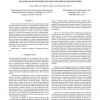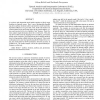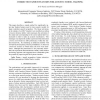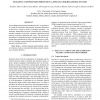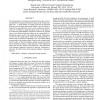ICASSP
2008
IEEE
14 years 9 months ago
2008
IEEE
We present a framework for speech recognition that accounts for hidden articulatory information. We model the articulatory space using a codebook of articulatory configurations g...
ICASSP
2008
IEEE
14 years 9 months ago
2008
IEEE
Language model (LM) adaptation is often achieved by combining a generic LM with a topic-specific model that is more relevant to the target document. Unlike previous work on unsup...
ICASSP
2008
IEEE
14 years 9 months ago
2008
IEEE
Networked embedded acoustic sensors and imagers allow scientists to observe biological and environmental phenomena at high sampling rates and multiple scales. Such sampling can cr...
ICASSP
2008
IEEE
14 years 9 months ago
2008
IEEE
A top-down task-dependent model guides attention to likely target locations in cluttered scenes. Here, a novel biologically plausible top-down auditory attention model is presente...
ICASSP
2008
IEEE
14 years 9 months ago
2008
IEEE
This paper describes a simple method for significantly improving Tandem features used to train acoustic models for large-vocabulary speech recognition. The linear activations at ...
ICASSP
2008
IEEE
14 years 9 months ago
2008
IEEE
A knowledge representation formalism for SLU is introduced. It is used for incremental and partially automated annotation of the MEDIA corpus in terms of semantic structures. An a...
ICASSP
2008
IEEE
14 years 9 months ago
2008
IEEE
ICASSP
2008
IEEE
14 years 9 months ago
2008
IEEE
Using a recently developed real time audio camera, that uses the output of a spherical microphone array beamformer steered in all directions to create central projection to create...
ICASSP
2008
IEEE
14 years 9 months ago
2008
IEEE
The theory of compressed sensing shows that samples in the form of random projections are optimal for recovering sparse signals in high-dimensional spaces (i.e., finding needles ...
ICASSP
2008
IEEE
14 years 9 months ago
2008
IEEE
The emerging theory of compressed sensing (CS) provides a universal signal detection approach for sparse signals at sub-Nyquist sampling rates. A small number of random projection...
